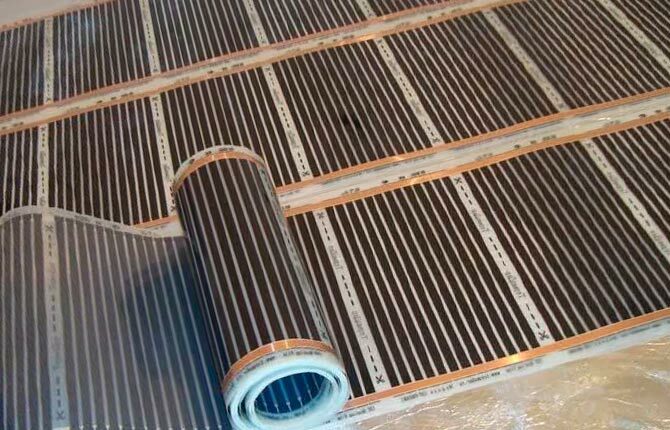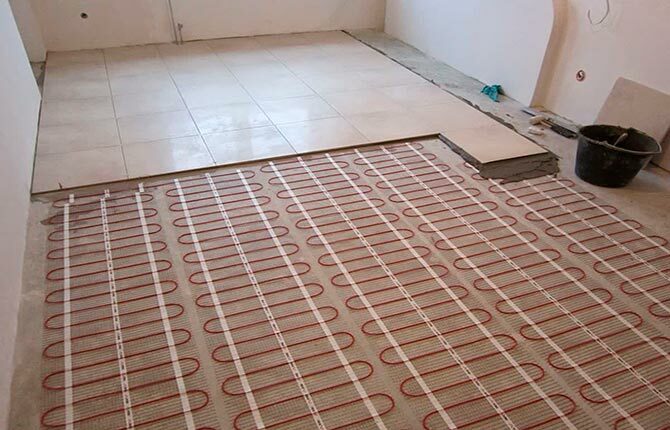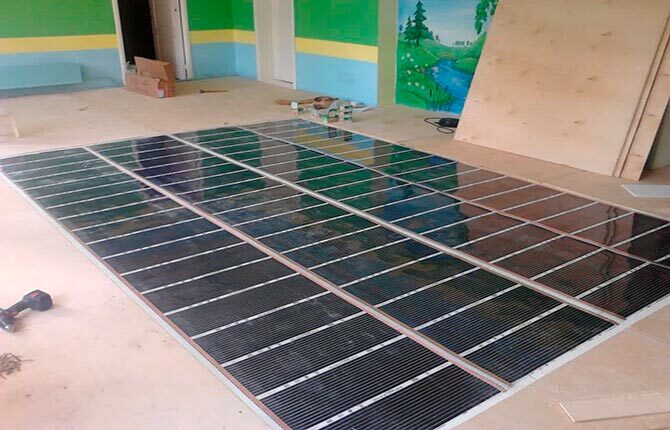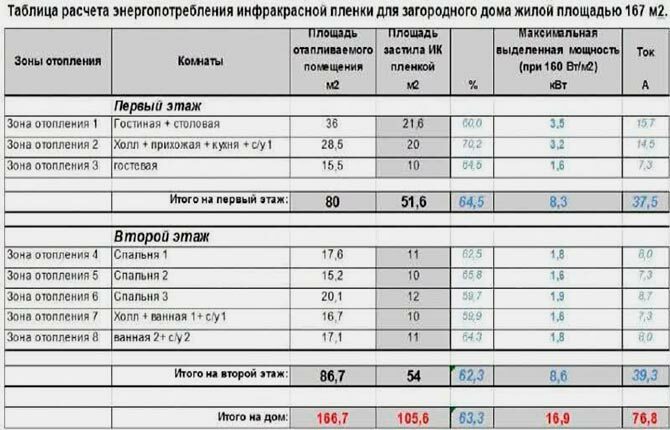Underfloor heating is a great idea, with all its complexities and shortcomings. The first thing you need to pay attention to when choosing a model is the consumption of a warm floor for electricity. It depends on whether such heating will be comfortable and economical at the same time.
The content of the article:
- The main types of electric underfloor heating
- Comparative analysis of the consumption of underfloor heating by type
- Calculation of electricity costs by type
- Energy costs depending on the finish coat
- Calculation of energy costs by electric floors depending on the type of premises
-
How to reduce electricity consumption
- Temperature controller and additional control sensors
- Thermal storage
- The new principle of heating zoning
The main types of electric underfloor heating
For the house and residential premises, 4 types of heating devices are used:
- Graphite film floors in the form of finished film panels with a conductive coating.
- Film resistive floors with a metallized coating.
- Cable heat-insulated floors in the form of ready sections stranded.
- Rod infrared floors.
From the point of view of financial costs, heating with electric underfloor heating is less profitable than using water embedded systems connected to a gas boiler. In theory, the use of mains gas is beneficial, even if you use an electric underfloor heating with a programmable thermostat. But in practice, not everything is so clear:
- The cost of a water-heated floor is greater than that of cable or film models.
- It is easier to manage energy consumption, which makes it possible to optimize costs.
- The calculation shows that the payback of a water-heated floor with a gas boiler is 5-7 years. Only for 8-9 years can we say that heating costs are minimized in comparison with the electric option.

Comparative analysis of the consumption of underfloor heating by type
Film floor heating is graphite strips sprayed onto a polymer base from a mixture of terephthalate and polyethylene. There are options with a continuous graphite field. Mat width - from 50 cm, 80 cm or 100 cm.
On a square meter, it emits from 100 W / h, 150 W / h, 220 W / h, 400 W / h. Special models can produce from 400 to 800 W/h per 1 m2. The maximum heating temperature of the material is up to 50 aboutC, efficiency - 92%. Service life - up to 25 years, a guarantee for branded underfloor heating up to 15 years. South Korean films produced by HEAT PLUS have a warranty period of up to 50 years.
Resistive film floors differ from graphite floors by the material of the heat-releasing layer. Typically, this is aluminum sealed between two polyester films. Power consumption - 140-150 W per square meter, maximum film heating temperature - 120 aboutC, working - 80 aboutFROM.
The film is quite capricious, and is not suitable for any floor covering, efficiency - 89-90%.
The cable for underfloor heating has a heat dissipation of about 20 W per linear meter of wire length. The heater is sold in separate lengths of 8 m, 12 m, 18 m, 22 m, 25 m, 50 m. Heat dissipation power from one square meter - 100-150 watts. Efficiency - 90%.

Rod warm floor - these are individual rods (rods) fixed on a polymer mat. Consumes 60-80 W/m2. Underfloor heating is sold in ready-made strips, laid in a layer of glue before laying the tiles. Efficiency - 91-92%.
Calculation of electricity costs by type
For a correct assessment of the future energy consumption, it is necessary to take into account the design features of the heating part of the underfloor heating.
The first factor affecting the consumption of electricity is the operating temperature and the heating area of the warm floor.
The lower the degree of heating of the electric cable or film, the lower the losses from the heater to the environment - to the concrete base, wooden substrate or insulation layer.
In this sense, graphite films in terms of energy costs will be more efficient than cable underfloor heating. Resistive models will have the highest costs, as they are the hottest of all.
On the other hand, the uniformity of floor heating affects the energy consumption. In this case, cable and rod floors look more attractive, since local overheated areas form on them during operation.
The heat transfer from the warm cable floor is higher, the air above the "hot lines" heats up more intensively. In addition to infrared heat transfer, air convection is added, which is more efficient than radiation. As a result, the air in the room heats up faster, less loss at the same power consumption.

Only core heated floors could be more efficient in terms of consumption, but their design involves laying under tiles or in a concrete screed. Electricity consumption of a warm floor increases due to losses on the end (side) surfaces and through the draft base.
Energy costs depending on the finish coat
The most unsuccessful in terms of minimizing energy consumption can be considered wooden log floors and laminate. For conventional electric heating, the bases are practically not used due to the large thickness of the floorboards and the presence of an air gap between the finishing floor and the rough filing.
In addition, a high-quality laminate should be laid on a shock-absorbing substrate made of pressed needles or polyethylene foam. Otherwise, the end locks on the lamellas will be quickly broken.
Underfloor heating film mats are recommended to be laid under the leveling substrate. But because of this, the heating efficiency decreases, and the energy consumption increases.

If you cover the warm floor with carpet or lay a carpet, then the energy consumption will only increase. Therefore, it makes sense to abandon traditional carpet products, and to combat noise, use special substrates for laminate. They not only extend the "life" of heating films, but also reduce electricity consumption due to good reflectivity.
The efficiency of cable heating systems under the screed, in theory, should be higher, if only because the laid on top of it, the tiles have about 2.5 times higher thermal conductivity than pressed panels paper.
But the lowest power consumption for cable underfloor heating shows the usual baseless linoleum, pasted on a cement-sand screed. In this case, the savings will be 15-20%. It is worth replacing the DSP with a bulk self-leveling floor, as the energy consumption rises sharply to the level of film heaters.
Calculation of energy costs by electric floors depending on the type of premises
The amount of electricity consumed by a warm floor is also affected by the type of room, as well as the features of its use. The largest room in any house or apartment is the living room. According to the operating conditions, it is possible to heat the floor surface that is not occupied by furniture. For example, in a living room of 20 m2 approximately 40% is occupied by furniture, including upholstered furniture. The remaining 60% (12m2) occupies the laminate.
Film heat-insulated floor made in South Korea will be used for their heating. Floor power per 1 m2 – 220 Wh. For heating the living room in normal mode, 80 W / h is enough with a total consumption of 1600 W / h. In the heating mode in the early morning or on cold days - 150-200 W / h, with a total consumption of 1.8-2 kW / h. It is difficult to calculate exactly, but per month - up to 360 kW / h for an apartment of 60 m2.

In the kitchen and hallway, a cable heater is used, which is laid under the tiles over the entire surface. In addition to the flow rate (80-100 W / h is enough), the maximum heating temperature of the cable is important. It must be at least 80aboutWith for effective drying of a surface and ventilation of the room.
The same approach is used for bathroom and toilet. The only difference is that cable heating is laid under the tiles in the free space of the room. For example, you can make a path one mat wide (50 cm) from the door to the washbasin. Electricity consumption will be only 120-150 W / h, but, unlike other rooms, in this case the warm floor will work constantly.
A similar scheme is used for bedrooms and children's rooms, but based on graphite film floors. Electricity consumption in these rooms usually does not exceed 600-800 W/h.
How to reduce electricity consumption
Electric underfloor heating in comparison with water has one drawback. When using film and cable heating, it is difficult to save energy.
With water, it is easier, for example, to heat the coolant in an electric boiler at the expense of the night tariff, and use it for heating the rest of the time, and thereby reduce the cost of paying for electricity.
For electric underfloor heating, there are several ways to save:
- Programmable thermostat.
- Thermal accumulator.
- Zoning of the heating system.
Proper zoning of places for laying heating systems helps to reduce energy consumption. First of all, you need to abandon the laying of underfloor heating elements in drafts and under exhaust vents.
Temperature controller and additional control sensors
Gives the best effect thermostat with software control. Modern models of thermostats (smart home system) are controlled by more complex programs that are capable of track the temperature of the air outside, the degree of heating of the warm floor in the room using an infrared non-contact thermometer. In general, for an apartment or house, a “smart” thermostat can reduce consumption by another 15%.
It is believed that promising models of AI-powered thermostats that can download and analyze the weather forecast will be able to adjust the operation of the warm floor in advance. How much exactly is hard to say. It may be possible to reduce by another 10%. Although the underfloor heating system itself will not be cheap to maintain and set up.
Thermal storage
An easier way to reduce energy consumption is to use a concrete screed (slab) as a heat accumulator. But in order to get a positive effect, the base of the slab and the ends must be qualitatively insulated with high-density foam or foam plastic with a thickness of at least 100 mm.
Heat is accumulated during the operation of a cable or more often a resistance heater at night, when electricity consumption is billed at a reduced or preferential rate. Due to the large mass of concrete, heat is released evenly, within 5-6 hours, immediately after the cable heating is turned off. Savings in consumption with the right settings can reach 15-18%.
The new principle of heating zoning
One of the ways to save heat is to lay film heaters not in the form of panels for the entire length of the room, but in squares (sections) of 25-50 cm each. Each such section of the warm floor is connected with its own pair of wires to a programmable switch.
As a result, you can set up a dozen different floor heating schemes, in which only a small part of the room is heated. In general, the system turns out to be rather cumbersome, but not complicated. Electricity consumption can be reduced by 10-12%.
Reducing the consumption of underfloor heating is quite possible, but it requires painstaking preparatory work even at the stage of designing the base and laying the floor covering. If you combine several methods, you will be able to reduce heat loss in total up to 20%.
Share your experience, the simplest ways to save energy and reduce electricity consumption in the comments. Bookmark the article so that useful information is always available.


